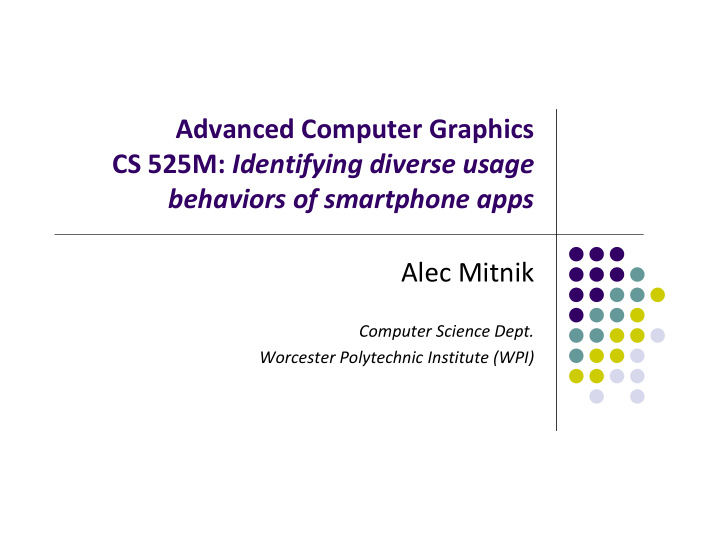



Advanced Computer Graphics CS 525M: Identifying diverse usage behaviors of smartphone apps Alec Mitnik Computer Science Dept. Worcester Polytechnic Institute (WPI)
Introduction The popularity of mobile devices is increasing. Apps are becoming more mainstream. There are over 350k apps at the iOS AppStore with over 10 billion downloads. Companies are developing apps instead of just web ‐ based services. We don’t know nearly as much about app usage as web usage.
Related Work Existing studies of app usage have been isolated and small scale. This project wishes to gather nation ‐ wide data for location and time based variations. Other studies have used an app that relied on volunteer measurement. This is too challenging, as many APIs don’t enable measurement of other apps.
Methodology Collect anonymized network traces within a tier ‐ 1 cellular network in the U.S. for one week. Use HTTP headers and user agents to distinguish individual apps and locations.
Methodology Record four main features for each app: Traffic volume Access time Unique subscribers Locations Use uniform random sampling to prevent traffic overflow. Only recognize apps involving network flows, but the interest of the study is just such apps anyway.
Results Recorded data for a total of about 600K individual devices and about 22K individual apps. When analyzing traffic volume, access time, and number of subscribers, many apps have very small values and do not provide enough data to analyze, so are excluded from detailed analysis.
Traffic Volume Note that app and web browsing traffic are comparable, and the significant market traffic.
Access Time Gaming, p2p, and voip seem to not be commonly used on the captured devices.
Unique Subscribers The misc value reflects the total number of subscribers. Almost all use web browsing and apps.
Results for Smartphone Apps Only
Results Normalized by Subscribers A few big values, but most are very small. Must filter out small values for proper analysis.
Filtering Results Over 90% of total traffic and access time is contained within the 1000 most ‐ subscribed apps.
Results for Location 20% of popular apps are local, such as radio or news. Amounts to 2% of total traffic.
Results for Location of “National” Apps, by Genre
Results for Mobility About 10% of apps access the network more than two sectors. Most mobile apps are social networks or games.
Results for Correlation A JSC of 0.05 for two apps with 2000 subscribers each means 100 subscribers use both. Popular apps share more subscribers, naturally.
Results for Temporal Patterns
Results for Devices More advanced devices consume more traffic. Power users likely upgrade to latest devices.
Conclusions Findings show many opportunities for optimization (such as moving content to local servers) and profiling (for recommending apps). Some apps are often used together, and some types of apps have alternatives that are interchangeable. There are trends in time of use (news in morning, sports in evening). There are trends in use while stationary or mobile. Results are mostly intuitive...
Thoughts Very broad and thorough analysis, but bland results. Is one week really long enough? Weather app usage during hurricane season Why not name specific companies? Tier ‐ 1 cellular network Personalized Internet radio app Social utility connecting people app (Facebook?) 6 out of 7 devices use it, according to the data Graphs should use different colors instead of or in addition to different patterns.
References Identifying diverse usage behaviors of smartphone apps Qiang Xu, Jeffrey Erman, Alexandre Gerber, Zhuoqing Mao, Jeffrey Pang, Shobha Venkataramanin in Proc IMC 2011 http://delivery.acm.org/10.1145/2070000/2068847/p329 ‐ xu.pdf?ip=130.215.29.166&acc=ACTIVE%20SERVICE&CFID=16 0083051&CFTOKEN=61884003&__acm__=1357578921_fd49 d3071b1b7accda3adef7c2eeb94c
Recommend
More recommend